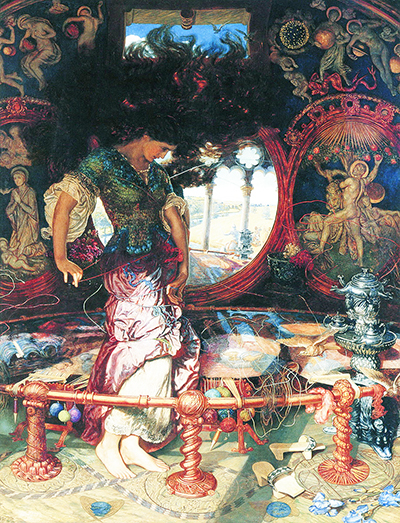The English painter William Holman Hunt co-founded the Pre-Raphaelites in 1848. The group was influenced by medieval art, and in the case of The Lady of Shalott, Hunt reflected Tennyson's 1832 poem of the same name, which in turn referenced an Arthurian tale.
The poem's subject is shut in a tower overlooking the river that runs to Camelot, cursed to never look outwards or to leave her room, and able to see the outside world only via a mirror, weaving its reflections into a tapestry web. A sneaked glance at Sir Lancelot brings about catastrophe, however, and as she looks upon him, the mirror cracks and the curse comes to pass. She leaves her tower and clambers into a boat to meet her fate.
Holman Hunt has depicted the moment when the curse comes upon the Lady of Shalott, rather than portraying her doomed journey, as others have done. As the mirror breaks, the threads of the unravelling tapestry ape her wild hair, startling some doves, and the whole picture conveys the chaos, shock, panic and confusion of her state of mind. Weavers at the time would put a looking-glass on the far side of their tapestry for a better all-round view, so this really is a breakdown of order. The one in this painting harks back to the convex mirror in Van Eyck's The Arnolfini Portrait, a work admired by the Pre-Raphaelites.
However, the picture underwent some changes before Hunt had finished with it. An 1850 drawing went through several stages until it became part of the Moxon Tennyson gift book in 1857, and then finally, Hunt produced this small oil on panel painting of 1886 that is in Manchester Art Gallery today. The lesson of this tale is suggested by the figures on each side, Hercules and the Virgin Mary, who both faced obligations and challenges without giving in to personal desires, accepting their fate instead.
The Three Fates at the top emphasise the point that facing one's duties leads to rewards in the after-life, so Hunt, a devout Christian, may have been comparing the artist's integrity with the temptations of celebrity and other pressures that the Lady of Shalott could not resist. The three founders of the group, William Holman Hunt, Dante Gabriel Rosetti and John Everett Millais, drew in some younger members as time went on, with Edward Burne-Jones and William Morris taking the concept to a more mystical and stylised level, leaving Burne-Jones as perhaps the best-known of the pre-Raphaelites today. The Lady of Shalott was also painted by John William Waterhouse, an artist closely related to the Brotherhood.




